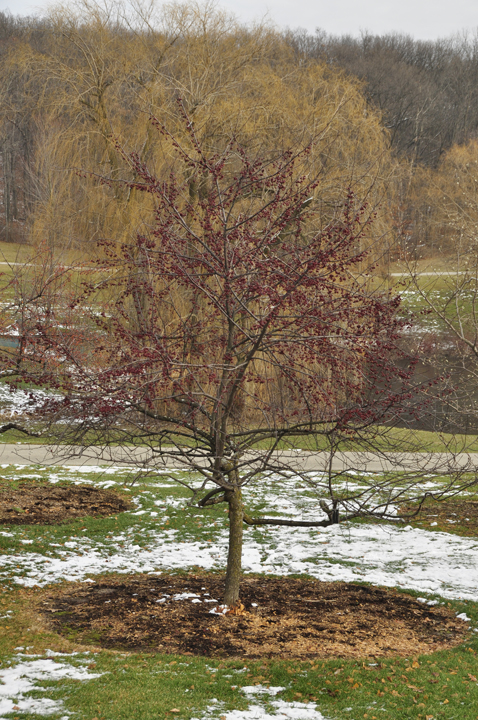Color really pops on
December's gray days.
Plant breeding during the last 30-some years has given us many
new disease resistant crabapples that hold colorful fruit long into
the fall. Some hold the fruit right through winter. Gardeners
embraced the plants for this additional season of interest, and the
fruit's attraction to birds. So chances are that you drive past far
more of them than those who were on the road in the 1960's.
We think the birds have adapted their habits to the presence of
so many feeding stations, so that we city folk are seeing far more
fruit eaters such as cedar waxwings than ever before. (Along with
all the other animals who favor this fruit, from geese to turkey,
deer, groundhog and fox.)
(Thinking of planting a crabapple? See below.)
We love the wide range of crabapple fruit color. This year
we've made our best attempt so far to capture it, although it still
falls short of conveying the full gold to purple sweep of color,
and the luminosity of some. Given hundreds of crabapple varieties,
dozens of those with persistent fruit, we may be a long time
completing this collage.

A - 'Silver Drift' B -
'Candy Mint' C -
'Prairifire' D - 'Halliana
Spontanea' E - 'Red Jewel'
F - 'Morning Sun' G -
' Sugar Tyme' H -
'Excalibur' I -
'Adams' J - 'Golden
Harvest' K - 'Sargent'
L - 'Dorothea'
M - 'Zumi Winter Gem'
N - 'Ormiston Roy' O
- 'Prairie Maid' P - 'Tina'
To learn
more about these trees' sizes, flowers and so on...
Our quest may also require lessons in fruit preservation, in
order to compare fairly when days must pass between collecting from
one type of tree and tracking down the next.

 See these
larger!
See these
larger!
Look at the difference in staying power of the fruit.
Several days went by between when we collected and catalogued the
fruit, then made the collage; the fruit was refrigerated in the
meanwhile, as if it was outdoors.) Compare how 'Dorothea' fruits
held up, as compared to 'Zumi Winter Gem.'
We'll look again in January, when perhaps the only trees in this
group still hanging onto their fruit will be 'Adams', and the
Sargents ('Candy Mint', 'Sargent' and 'Tina').
If you might plant a crabapple
in the near future...
...go now to look at the collection in a local arboretum or
botanical garden. Choose for the appearance of the whole tree. If
you like it in early winter, it's a keeper of a crab! Better to
choose for fruit, rather than flower color, since bloom is such a
brief asset compared to the tree's fruit display.
'Red Jewel' in the foreground with 'Sugar Tyme' behind to
the left, and to the right a floribunda crabapple. We tell you who
want privacy to plant floribunda for its dense twigginess even in
winter, but maybe after seeing the real trees you'll choose winter
color over privacy.
 (larger
please!)
(larger
please!)
The trees you see here are in Hidden
Lake Gardens, one of Michigan State University's off-campus
facilities. Many other parks have fine collections:
the Arnold Arb in
Jamaica Plain, Massachusetts;
Cornell Plantations in Ithaca, New
York;
Dawes Arboretum in Newark, Ohio;
Holden Arboretum in Kirtland,
Ohio;
Morton Arboretum in Lisle,
Illinois;
University of Wisconsin
Arboretum in Madison, Wisconsin;
Minnesota Landscape
Arboretum in Chanhassen, Minnesota;
Bicklehaupt Arboretum in Clinton,
Iowa; and many more.
Parting look: 'Prairifire' showing off against the backdrop
of a willow.

Back to
top